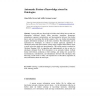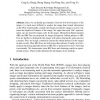321 search results - page 58 / 65 » The Semantic Web: From Representation to Realization |
IDT
2010
13 years 5 months ago
2010
A person adds new knowledge to his/her mind, taking into account new information, additional details, better precision, synonyms, homonyms, redundancies, apparent contradictions, a...
APWEB
2006
Springer
13 years 10 months ago
2006
Springer
Since we can hardly get semantics from the low-level features of the image, it is much more difficult to analyze the image than textual information on the Web. Traditionally, textu...
MEDINFO
2007
13 years 8 months ago
2007
Managing time-stamped data is essential to clinical research activities and often requires the use of considerable domain knowledge, which is difficult to support within database ...
WWW
2007
ACM
14 years 7 months ago
2007
ACM
Discovering mappings between concept hierarchies is widely regarded as one of the hardest and most urgent problems facing the Semantic Web. The problem is even harder in domains w...
SWAP
2008
13 years 8 months ago
2008
Abstract. The limitations of deductive logic-based approaches at deriving operational knowledge from ontologies may be overcome by inductive (instancebased) methods, which are usua...


